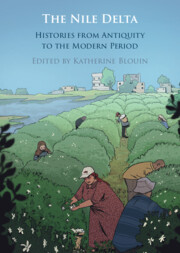Book contents
- The Nile Delta
- The Nile Delta
- Copyright page
- For Mona Abaza
- Contents
- Figures
- Maps
- Tables
- Contributors
- Acknowledgements
- Abbreviations
- 1 Introduction
- 2 Call Me by My Names
- 3 The Nile Delta before the Pharaohs
- 4 The Khetem-Border-Posts in the Delta during the New Kingdom
- 5 New Land amongst New Rivers?
- 6 The Mareotis Area
- 7 From Memphis to Alexandria
- 8 Growing with the Empire? From Village to Town
- 9 Mapping the Cult of Christian Saints in the Nile Delta from the Fifth to the Ninth Century CE
- 10 Alexandria
- 11 Imperial Power, Tribal Settlement and Fiscal Revolts in the Early Islamic Delta (Seventh to Ninth Century CE)
- 12 The Nile as Nexus
- 13 Water and Prices
- 14 Water Development in the Medieval Western Delta
- 15 The Nile Delta in European Cartography, 1200–1800
- 16 Just Passing Through?
- 17 Reclaiming the Archive
- 18 Short Commentary on Accounting Documents from a Vanishing Cotton Estate (ʿIzba) in the Nile Delta
- Index
- References
16 - Just Passing Through?
The Nile Delta, Colonial Modernity and the Egyptian Tourist Economy (ca. 1870–1914)
Published online by Cambridge University Press: 15 February 2024
- The Nile Delta
- The Nile Delta
- Copyright page
- For Mona Abaza
- Contents
- Figures
- Maps
- Tables
- Contributors
- Acknowledgements
- Abbreviations
- 1 Introduction
- 2 Call Me by My Names
- 3 The Nile Delta before the Pharaohs
- 4 The Khetem-Border-Posts in the Delta during the New Kingdom
- 5 New Land amongst New Rivers?
- 6 The Mareotis Area
- 7 From Memphis to Alexandria
- 8 Growing with the Empire? From Village to Town
- 9 Mapping the Cult of Christian Saints in the Nile Delta from the Fifth to the Ninth Century CE
- 10 Alexandria
- 11 Imperial Power, Tribal Settlement and Fiscal Revolts in the Early Islamic Delta (Seventh to Ninth Century CE)
- 12 The Nile as Nexus
- 13 Water and Prices
- 14 Water Development in the Medieval Western Delta
- 15 The Nile Delta in European Cartography, 1200–1800
- 16 Just Passing Through?
- 17 Reclaiming the Archive
- 18 Short Commentary on Accounting Documents from a Vanishing Cotton Estate (ʿIzba) in the Nile Delta
- Index
- References
Summary
As with practically everything in 19th and early 20th century Egypt, we must consider the colonial context of foreign ‘viewings’ of the Nile Delta. Tourists pulled to the top of the Great Pyramid by Egyptian guides look down on a scene onto which they project their own recent experiences of Egypt and their knowledge of its history. They look, in the words of Mary Louise Pratt, with ‘imperial eyes’. When they venture into the landscape of the Delta itself, such as on the sporting trips recommended in Cairo of To-Day, they move through a landscape whose infrastructure and, to a certain extent, socio-economic system are the products of imperialism, and also of Egyptian nation-building in an international, imperial context. In this chapter, I shall explore these themes of modernity and imperialism through a superficially innocent genre of writing – the Euro-American travelogue – and a more overtly political genre – the contemporary Egyptian autobiography. For both, the late 19th and early 20th century Delta is in a sense a place of lost innocence, although they survey its landscape from two very different viewing platforms. The tension between the Delta of the shadūf and the Delta of the railway is always present.
- Type
- Chapter
- Information
- The Nile DeltaHistories from Antiquity to the Modern Period, pp. 569 - 594Publisher: Cambridge University PressPrint publication year: 2024



